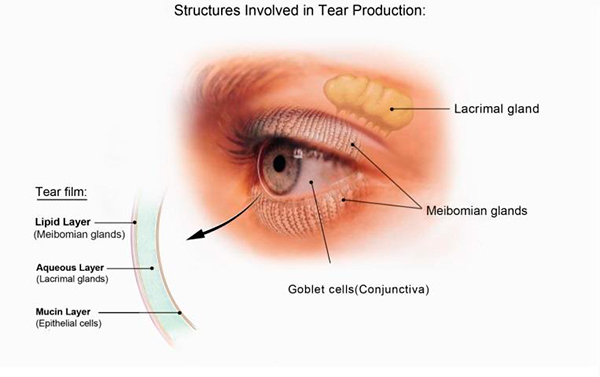Joseph R. Anticaglia MD
Medical Advisory Board
Dry eye happens when the quantity and/or quality of tears aren’t enough to lubricate the surface of the eye. It’s an undertreated condition that affects millions of Americans particularly above 50 years of age. It’s more common in women and the risk of getting dry eye increases as you get older.
Symptoms
Dry eye causes a scratchy-gritty sensation that varies in intensity. Other symptoms might include:
- Itchiness
- Redness in the eye
- Eyelids feel heavy
- Stinging or burning sensation
- Sensitivity to light
- Difficulty wearing contact lenses
- Blurry vision
Sometimes dry eye behaves as if you have a speck of dirt in your eye producing lots of tears. This watery-reflex tearing may wash away the debris from the eye but it doesn’t protect the surface of the eye. What follows is a peek into the makeup of tears.

Source NIH National Eye Institute
Tears
The tear film (tears) is the thin layer of secretions outside the cornea and white of the eye. It works to provide comfort, clear vision and to promote corneal health. It keeps the surface of the eye smooth and contains antibodies that protect the eye. The film consists of three layers: mucus, water and fatty oils.
- Mucus layer: allows water to spread out over the cornea. It’s produced by the cells of the conjunctiva.
- Oily-lipid layer: It’s the oily substance on the surface of the eyes that reduces evaporation. It’s produced by the Meibomian glands located in the eyelids.
- Watery layer: It’s produced by the lacrimal glands and washes away debris from the eye. The glands are located under the brow.
- Antibodies and proteins are also found in tears. They fight infection.
There are no blood vessels in the cornea and it depends on tears for its health. With every blink of the eye, tears nourish and protect the cornea and surface of the eye. There are many reasons why tears may become inadequate and cause dry eye.
Causes of Dry Eye
- Decrease tear production
- Increase tear evaporation
- Tear composition imbalance
Decrease Tear production
Janet is a 42y/o woman with perennial (all year) allergies. She was a contact lens failure because the medications she was taking for her allergies and hypertension gave her dry eyes. Other causes of decrease tear production might include:
Advancing age: Dry eye is more common in people 50 years of age or older
Medical conditions: Diabetes, Rheumatoid arthritis, Sjogren’s syndrome, Lupus
Medications: antihistamines, antidepressants, drugs for hypertension,
Tear gland damage due to inflammation
Laser eye surgery, the symptoms when present are usually temporary.
Increase Tear Evaporation
George rides a motorcycle to and from work and the trip takes about 45 minutes each way. Over time, the windy conditions caused him to experience many of the symptoms due to dry eyes. Of note, he developed fleshy tissue over the eyeball (pterygium) that contributed to his complaint of blurry vision. Additional causes of increase tear evaporation:
Smoky, windy, dry air environments
Blinking less often; for example, working at a computer
Eyelid problems: outward turning of the lids away from the eyeball (ectropion);
inward turning of the eyelids against the eyeball (entropion).
Tear Composition Imbalance
Problems with the tear film’s basic layers (mucus, fatty oils and water) can result in dry eyes. Blepharitis is an inflammation most often involving the part of the eyelids where the eyelashes grow. The eyelids are red, swollen, itchy and sticky.
This inflammation can result in a decrease in the secretion of the oily substance by the Meibomian glands onto the surface of the eye causing an increase in tear evaporation. Rosacea and other skin conditions can disrupt the function of the eyelid glands.

Source: NIH American Academy of Ophthalmology
Tears are washed toward the nose and drain into the nose and throat. The progression of tears from the eye on its way to the tear duct and ultimately into the nose helps explain why we taste eye drops when we put them into the eye.
Treatment
People should consult an ophthalmologist (eye physician specialist) to diagnose and treat dry eye. Artificial tears may be all that’s required in mild cases. Doctors may prescribe eye drops that increase the eyes’ natural ability to produce tears for moderate cases of dry eye. At other times, antibiotic eye drops, steroids or oral antibiotics may be needed to treat the person.
In advanced cases, when the symptoms become more intense, it’s crucial to accurately diagnose and treat the problem to prevent lasting damage to the eye. Surgical intervention plus the above medical treatment may be necessary to resolve the problem.
Dry eye is a problem that is underappreciated. Our eyes need the right quantity and quality of tears for us to be comfortable and healthy. If you have dry eyes, seek the consultation of an eye specialist to get the care you need for this problem.
References
Maurizio Rolando et al; The correct diagnosis and therapeutic management of tear dysfunction; Int Ophthalmol 2018
Franklin W. Lusby, MD; Dry Eye Syndrome; Medline Plus. Dec 19, 2016
Personal referenced communication: Kenneth R. Pearlberg MD FACS
This article is intended solely as a learning experience. Please consult your physician for diagnostic and treatment options.

